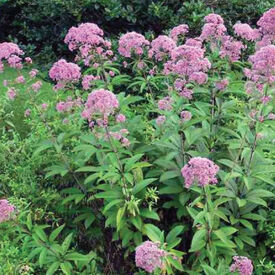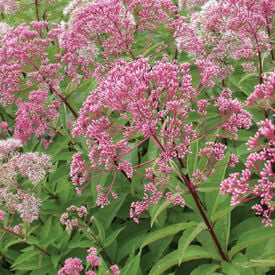Learn More
Joe Pye Weed (Eutrochium maculatum), also known as Spotted Joe Pye Weed, is a distinctive perennial native to North America's moist meadows and woodlands. Named after Joe Pye, a Native American herbalist, this plant has a rich history in traditional medicine. It is recognized for its tall, elegant growth, typically reaching heights of 4 to 6 feet, and its unique spotted stems that give it its common name. The plant features large, lance-shaped leaves with prominent white spots or speckles along the stem. In mid to late summer, Eutrochium maculatum produces dense, rounded clusters of small, pinkish-purple flowers that attract a wide range of pollinators, including butterflies and bees. The seeds, which are lightweight and tufted, facilitate wind dispersal. Joe Pye Weed thrives in moist, well-drained soils and is valued for its ability to add height and texture to garden beds and naturalized areas. With its striking appearance, vibrant blooms, and ecological benefits, Joe Pye Weed is a cherished addition to both cultivated gardens and native plant landscapes.
The Sweet Joe Pye Weed Eutrochium is easy to grow and its vanilla-scented flowers are irresistible for Monarchs, Swallowtails and many other butterflies. If you want to attract butterflies to your garden, this is the plant variety for you! The Sweet Joe Pye Weed can reach up to 7 feet high and does great in shady locations. This beautiful flower blooms pale pink to pale purple flowers from July to September.
Boneset (Eupatorium perfoliatum) is a native North American herb with a rich history and distinctive characteristics. Historically used by Indigenous peoples for its medicinal properties, Boneset earned its name from its traditional use in treating fevers and musculoskeletal ailments. Originating from the eastern United States, this perennial plant is recognized for its unique features and growing habits. Boneset typically grows to a height of 3 to 4 feet and has a bushy, upright growth habit. Its leaves are opposite and deeply veined, creating a striking appearance. In late summer to early fall, the plant produces clusters of small, white to pale pink flowers that are highly attractive to pollinators such as bees and butterflies. The seeds of Boneset are borne in fluffy, dandelion-like clusters, aiding in wind dispersal. With its historical significance, robust growth, and attractive bloom, Boneset remains a valuable addition to both medicinal gardens and natural landscapes.



